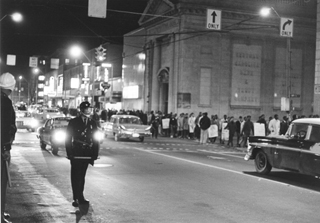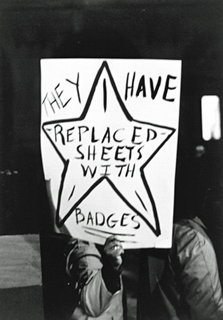Protesting Police Brutality – The Aftermath of Orangeburg 1968
Five Points Plaza - W. Main at W. Chapel Hill Street, Durham, NC 27701
On February 8th, 1968, the police shot and killed three unarmed Black student protesters and injured dozens of others at South Carolina State University in Orangeburg. In the aftermath of this massacre, civil rights leaders organized coordinated demonstrations in cities across the South. However, the Durham Orangeburg Protest marks the only such demonstration that became violent, an exception to the city’s long history of nonviolent protest.
On February 15, student protesters amassed at Five Points Park in downtown Durham for a sympathy service. During this protest, demonstrators held up signs reading, “They have replaced sheets with badges,” to connect the racial violence and terror of white supremacist organizations to government authorities and the police. They feared that the murder of young black college students in the Orangeburg Massacre would become a precedent for racial violence in the South.
The gathering quickly escalated when protesters lit a fire inside a coffin as part of the memorial and the police officials stepped in to intervene. However, instead of simply hosing down the fire, the Durham Fire Department also turned the hoses onto the crowd and policemen moved in with batons. In response to this escalation, protesters began smashing store windows along Main Street. Police officers responded by patrolling Durham’s downtown business district.
As a white police officer was poised to hit a restrained Black protester in the head, local civil rights leader Howard Fuller intervened. Instead of seeing Fuller as a defender against police violence, the police arrested him and charged him with assaulting an officer. Although Fuller denied the charges, the police report reads that Fuller hit an officer in the mouth with his elbow, which Fuller called “a goddamn lie.”
Most newspapers remained critical of the demonstration. An editorial in The Morning Herald the following Saturday blamed the violence on demonstration leaders. Even The Carolina Times, a black owned newspaper, reported condemning the protesters’ behavior. Nevertheless, this violent protest in Durham did not remain an isolated event; 1968 marked Durham’s transition into confrontational civil rights and anti-war protests. Young activists, led by organizers such as Howard Fuller and the growing Black Power movements challenged both the old guard of the civil rights movement and the white establishment.
Works Cited
- Davidson, Osha Gray. "Chapter 10." The Best of Enemies - Race and Redemption in the New South. Chapel Hill: University of North Carolina, 1196. 216-217. Print.
- Cerese, Rebecca. 2008. Change Comes Knocking: The Story of the North Carolina Fund, http://southerndocumentaryfund.org/projects/change-comes-knocking/ Film
- Boyarsky, Bill. "Orangeburg Sympathy Protest - 5 - Durham Civil Rights Heritage Project: Our Pictures and Stories - Durham County Library." Orangeburg Sympathy Protest - 5 - Durham Civil Rights Heritage Project: Our Pictures and Stories - Durham County Library. Durham County Library, n.d. Web. 08 Oct. 2012. <http://www.durhamcountylibrary.org/dcrhp/orangeburg4.php>.
- Greene, Christina. "The Sisters Behind Brothers." Our Seperate Ways. Chapel Hill: University of North Carolina, n.d. 65-67. Print.

